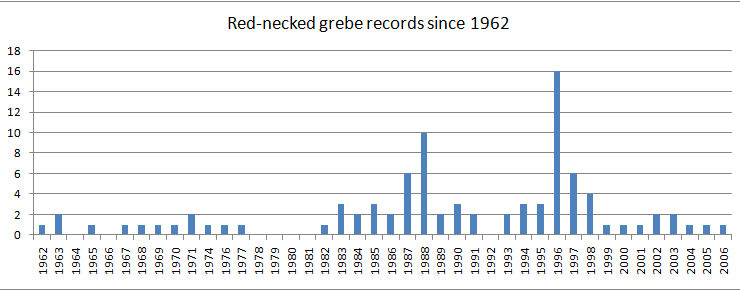The Snow Bunting has a circumpolar breeding distribution, inhabiting the treeless expanses of the Arctic, extending south to areas of Norway and Scotland. Partially migratory, many winter far south of the breeding range. Most occurring in Britain have been of the Icelandic race P. n. insulae but the nominate race P. n. nivalis has been recorded in lesser numbers.
Six single Snow Buntings are on record for Pembrokeshire between the years 1859 and 1914, indicating that the species did not loom large during the specimen collecting era, which is perhaps significant considering their striking appearance. Lockley et al (1949) noted that the Snow Bunting was “a regular visitor to Skokholm in October and November but only once seen in spring”.
For the whole county there followed records in 17 years between 1953 and 1969, in 14 years between 1970 and 1989 and in every year bar one between 1990 and 2007.The majority, 86 %, were recorded in the autumn, between mid September and December, the earliest being on the 11th September. Of these 50 % were recorded in October.
Mostly single birds were involved but parties of up to 10 were sometimes encountered, with up to 15 seen at Ramsey, up to 17 at Skokholm and up to 38 at Strumble Head. The mean county autumn total was 9 per annum, excluding exceptional numbers recorded in 1996 and 1999.
A total of 172 was recorded in 1999, of which a passage total of 115 on 16 dates was logged at Strumble Head. A total of 209 was recorded in the autumn of 1996, 160 of them spread over 10 dates passing Strumble Head.
Snow Buntings have been recorded in the autumn at Pen Morfa, Dinas Island, Strumble Head, Garn Fawr (Pen Caer), Pen Brush, Trefin, Abereiddi, Trwyn Llwyd, St David’s airfield, Treleddyn, St David’s Head, Porth Clais, Ramsey, South Bishop, Solva, Newgale, Nolton Haven, St Bride’s, Martin’s Haven, Wooltack Point, Skomer, Grassholm, The Smalls, Marloes Beach, Skokholm, Gann, Dale airfield, Kete, St Ann’s Head, Freshwater West, Castle Martin ranges, St Govan’s Head, Stackpole, Greenala and Garron.
It seems that Snow Buntings can be encountered anywhere in coastal areas during autumn passage. Single birds at Carn Ingli on the 24th October 2005 and at Foel Eryr on the 28th November 1985 are the only inland records at this time of the year, perhaps reflecting the paucity of observers away from the coast at passage time.
A small and erratic spring passage has been detected in coastal areas, with variously one to three birds at a time noted during March and April, in 14 years between 1958 and 2006. Single birds were also recorded at Manorbier on the 26th May 1991 and at Strumble Head on the 5th June 1959 and 19th August 2002, the latter “captured” on video.
References
LOCKLEY. R. M, INGRAM. C. S. and SALMON. H. M.1949. The birds of Pembrokeshire, West Wales Field Society.
 Thursday, August 18, 2011 at 11:47PM
Thursday, August 18, 2011 at 11:47PM  GHR,
GHR,  grebe,
grebe,  migration,
migration,  waterbird in
waterbird in  Little Grebe
Little Grebe 



